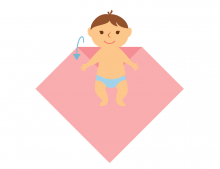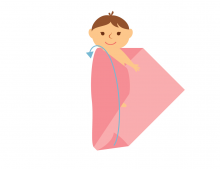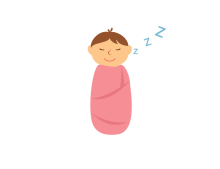Swaddling is a long-cherished tradition that is meant to replicate how the baby feels in their mother’s womb. It involves gently wrapping the baby with a light and breathable blanket. Swaddling is known for its ability to soothe the baby and put them to sleep. Babies who are swaddled usually feel snug, calm, and secure just as they would in the womb.
How to Swaddle your Baby
Although swaddling has proven to have positive results on falling asleep quickly and on how the baby feels, swaddling or wrapping the baby needs to be done with care. Follow the steps below as a guide to swaddling your baby.
Step 1:
Spread your swaddling blanket
Step 2:
Fold one corner of the swaddling blanket
Step 3:
Place your baby on their back with their head on the edge of the corner you folded.
Step 4:
Place your hand on your baby and bring the left corner of the swaddling blanket across your baby’s body
Step 5:
Tuck the swaddling blanket under your baby’s right arm and body to reach the lower back
Step 6:
Straighten your baby’s left arm on the side
Step 7:
Fold or loosely twist the bottom corner of the blanket
Step 8:
Bring the right corner of the blanket across your baby’s body and tuck it under the left side
You can also use a swaddle sack if you do not feel confident in your wrapping abilities yet.
Safety Tips when Swaddling
Swaddling is intended to soothe your newborn baby. However, not swaddling your baby the correct way could cause discomfort and give rise to certain risks.
Here are some safety tips to keep in mind:
Always place your baby on their back after swaddling.
Make sure that your swaddle is not loose. Your baby might wriggle out of the loose swaddle, and the swaddle might block their airway.
Make sure that your baby is not overheated due to the extra layer of the swaddle blanket. Consider using a cotton swaddle that is breathable. You can also touch your baby’s neck or chest to see if they are sweaty.
Always allow your baby’s legs some space to move. A tight swaddle might lead to hip dysplasia or dislocation. Allowing the baby’s legs to move as you swaddle would prevent this risk.
Stop swaddling when your baby is able to roll over, typically around 2 months old, according to the Academy of Pediatrics.
Benefits of Swaddling
Considering the safety measures mentioned above, swaddling has its benefits too! Aside from feeling snug, secure, warm, and content, here are some additional benefits to swaddling:
Benefit 1: Better Sleep
Swaddling provides your baby with better sleep. Swaddling replicates the feeling babies experience in the womb. When they feel cozy and secured, babies sleep for a longer period of time and are rarely startled awake by themselves.
Benefit 2: Less Crying
Swaddling gives your baby a sense of security. Babies under 2 months old cry less when they are swaddled.
Benefit 3: Placed on their Back
Babies who are swaddled are more likely to be placed on their backs when put down. This is a recommended sleep position for babies and significantly reduces the ‘sudden infant death syndrome.’
Finally, soothing your baby and providing them with a sense of security is guaranteed while you swaddle the baby. Essentially, you would be providing your baby with a safe transitory phase from life inside the womb to life outside it.







